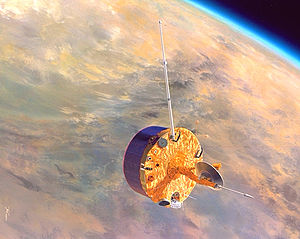Pioneer Venus project
From Wikipedia, the free encyclopedia
| Pioneer Venus Orbiter | |
|---|---|
 Pioneer Venus Orbiter |
|
| Organization: | Ames Research Center - NASA |
| Mission type: | Orbiter |
| Satellite of: | Venus |
| Orbital insertion date: | December 4, 1978 |
| Launch date: | 20 May 1978 |
| Launch vehicle: | Atlas-Centaur |
| Decay: | August, 1992 |
| Mission duration: | 20 May 1978 to August, 1992 |
| NSSDC ID: | 1978-051A |
| Webpage: | National Space Science Data Center (NASA) |
| Mass: | 517 kg |
| Power: | 312 W |
| Eccentricity: | .842 |
| Inclination: | 105° |
| Orbital period: | 24 h |
| Apoapsis: | 1.03 RV |
| Periapsis: | 12.01 RV |
| edit | |
The Pioneer mission to Venus consisted of two components, launched separately. Pioneer Venus 1, Pioneer Venus Orbiter was launched in 1978 and studied the planet for more than a decade after orbital insertion in 1978. Pioneer Venus 2, Pioneer Venus Multiprobe sent four small probes into the Venusian atmosphere. This was managed by NASA Ames Research Center as part of the Pioneer series of spacecraft that included Pioneer 10 and Pioneer 11.
Contents |
[edit] Pioneer Venus Orbiter
- Launch Date: 20 May 1978
- Launch Vehicle: Atlas-Centaur
- On-orbit mass: 517 kg
- Power System: Solar Array of 312 W
The Pioneer Venus Orbiter was inserted into an elliptical orbit around Venus on December 4, 1978. The Orbiter was a flat cylinder 2.5 m in diameter and 1.2 m high. All instruments and spacecraft subsystems were mounted on the forward end of the cylinder, except the magnetometer, which was at the end of a 4.7-m boom. A solar array extended around the circumference of the cylinder. A 1.09-m despun dish antenna provided S and X band communication with Earth. It was manufactured by Hughes Aircraft Company.
The Pioneer Venus Orbiter carried 17 experiments (with a total mass of 45 kg):
- a cloud photopolarimeter to measure the vertical distribution of the clouds
- a surface radar mapper to determine topography and surface characteristics
- an infrared radiometer to measure IR emissions from Venus' atmosphere
- an airglow ultraviolet spectrometer to measure scattered and emitted UV light
- a neutral mass spectrometer to determine the composition of the upper atmosphere
- a solar wind plasma analyzer to measure properties of the solar wind
- a magnetometer to characterize the magnetic field at Venus
- an electric field detector to study the solar wind and its interactions
- an electron temperature probe to study the thermal properties of the ionosphere
- an ion mass spectrometer to characterize the ionospheric ion population
- a charged particle retarding potential analyzer to study ionospheric particles
- two radio science experiments to determine the gravity field of Venus
- a radio occultation experiment to characterize the atmosphere
- an atmospheric drag experiment to study the upper atmosphere
- a radio science atmospheric and solar wind turbulence experiment
- a gamma ray burst detector to record gamma ray burst events
From Venus orbit insertion to July 1980, periapsis was held between 142 and 253 km (at 17 degrees north latitude) to facilitate radar and ionospheric measurements. The spacecraft was in a 24 hour orbit with an apoapsis of 66,900 km. Thereafter, the periapsis was allowed to rise (to 2290 km at maximum) and then fall, to conserve fuel. In 1991 the Radar Mapper was reactivated to investigate previously inaccessible southern portions of the planet. In May 1992 Pioneer Venus began the final phase of its mission, in which the periapsis was held between 150 and 250 km until the fuel ran out and atmospheric entry destroyed the spacecraft the following August.
[edit] Pioneer Venus Multiprobe
- Launch Date: 8 August 1978
- Launch Vehicle: Atlas-Centaur
- Mass: 290 kg (bus), 315 kg (large probe), 90 kg (each small probe)
- Power System: Solar Array of 241 W (bus), Batteries (probes)
The Pioneer Venus Multiprobe consisted of a bus which carried one large and three small atmospheric probes. None of these atmospheric probes had photographic imaging capabilities and were not designed for soil analysis (reaching the surface was considered a bonus).
The large probe was released on November 16, 1978 and the three small probes on November 20. All four probes entered the Venus atmosphere on December 9, followed by the bus.
| Large Probe | North Probe | Day Probe | Night Probe | Bus | |
|---|---|---|---|---|---|
| Entry Time (200 km) | 18:45:32 | 18:49:40 | 18:52:18 | 18:56:13 | 20:21:52 |
| Impact Time | 19:39:53 | 19:42:40 | 19:47:59 | 19:52:05 | (signal lost at 110 km altitude) |
| Loss of Signal | 19:39:53 | 19:42:40 | 20:55:34 | 19:52:07 | 20:22:55 |
| Impact Latitude | 4.4 N | 59.3 N | 31.3 S | 28.7 S | (37.9 S) |
| Impact Longitude | 304.0 | 4.8 | 317.0 | 56.7 | (290.9) |
| Solar Zenith Angle | 65.7 | 108.0 | 79.9 | 150.7 | 60.7 |
| Local Venus Time | 7:38 | 3:35 | 6:46 | 0:07 | 8:30 |
[edit] Bus
The Pioneer Venus bus portion of the spacecraft was targeted to enter the Venusian atmosphere at a shallow entry angle and transmit data until destruction by the heat of atmospheric friction. The objective was to study the structure and composition of the atmosphere down to the surface, the nature and composition of the clouds, the radiation field and energy exchange in the lower atmosphere, and local information on the atmospheric circulation pattern.
The bus was a 2.5 m diameter cylinder weighing 290 kg, and afforded us our only direct view of the upper Venus atmosphere, as the probes did not begin making direct measurements until they had decelerated lower in the atmosphere.
With no heat shield or parachute, the bus survived and made measurements with two instruments, an Ion Mass Spectrometer (BIMS) and a Neutral Mass Spectrometer (BNMS), up to an altitude of about 165 km on December 9, 1978.
[edit] Large probe
The Pioneer Venus Large probe was equipped with 7 science experiments, contained within a sealed spherical pressure vessel. The science experiments were:
- a neutral mass spectrometer to measure the atmospheric composition
- a gas chromatograph to measure the atmospheric composition
- a solar flux radiometer to measure solar flux penetration in the atmosphere
- an infrared radiometer to measure distribution of infrared radiation
- a cloud particle size spectrometer to measure particle size and shape
- a nephelometer to search for cloud particles
- temperature, pressure, and acceleration sensors
This pressure vessel was encased in a nose cone and aft protective cover. After deceleration from initial atmospheric entry at about 11.5 km/s near the equator on the Venus night side, a parachute was deployed at 47 km altitude. The large probe was about 1.5 m in diameter and the pressure vessel itself was 73.2 cm in diameter.
[edit] Small probes
The three small probes were identical to each other, 0.8 m in diameter. These probes also consisted of spherical pressure vessels surrounded by an aeroshell, but unlike the large probe, they had no parachutes and the aeroshells did not separate from the probe.
Each small probe carried a nephelometer and temperature, pressure, and acceleration sensors, as well as a net flux radiometer experiment to map the distribution of sources and sinks of radiative energy in the atmosphere. The radio signals from all four probes were also used to characterize the winds, turbulence, and propagation in the atmosphere.
The small probes were each targeted at different parts of the planet and were named accordingly.
- The North probe entered the atmosphere at about 60 degrees north latitude on the day side.
- The Night probe entered on the night side.
- The Day probe entered well into the day side, and was the only one of the four probes which continued to send radio signals back after impact, for over an hour.
[edit] See also
[edit] External links
- NASA: Pioneer Venus Project Information
- Pioneer Venus Program Page by NASA's Solar System Exploration
- NSSDC Master Catalog: Spacecraft Pioneer Venus Probe Bus. (Other components of the mission have their own pages at this site too.)
- Several articles in Science (1979), 205, pages 41-121
| Pioneer | ||
|---|---|---|
| Previous mission: Pioneer 11 | Next mission: Voyager | |
| Pioneer 0 • Pioneer 1 • Pioneer 2 • Pioneer 3 • Pioneer 4 • Pioneer P-1 (W) • Pioneer P-3 (X) • Pioneer P-30 (Y) • Pioneer P-31 (Z) | ||
| Pioneer 5 (P-2) • Pioneer 6, 7, 8 and 9 • Pioneer 10 • Pioneer 11 • Pioneer H • Pioneer Venus project | ||
|
|
|
|---|---|
| Flybys | Venera 1 • Mariner 2 • Zond 1 • Venera 2 • Mariner 5 • Mariner 10 • Venera 11 • Venera 12 • Venera 13 • Venera 14 • Vega 1 • Vega 2 • Galileo • Cassini-Huygens • MESSENGER |
| Orbiters | Venera 9 • Venera 10 • Pioneer Venus Orbiter • Venera 15 • Venera 16 • Magellan probe • Venus Express |
| Descent probes | Venera 3 • Venera 4 • Venera 5 • Venera 6 • Pioneer Venus Multiprobe |
| Landers | Venera 7 • Venera 8 • Venera 9 • Venera 10 • Venera 11 • Venera 12 • Venera 13 • Venera 14 • Vega 1 • Vega 2 |
| Balloon probes | Vega 1 • Vega 2 |
| Future missions | PLANET-C (2010) • BepiColombo • Venus Entry Probe (2013) • Venera-D (2016) |
|
See also: Colonization of Venus
|
|







